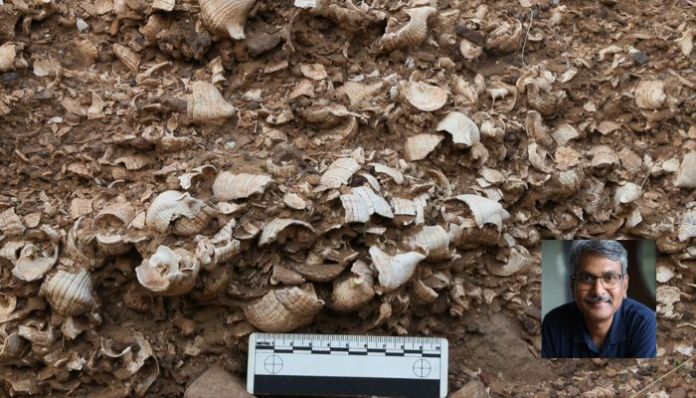The researchers from the Indian Institute of Technology Gandhinagar (IITGN), in collaboration with IIT Kanpur, IUAC Delhi, and PRL Ahmedabad, have discovered firm evidence of pre-Harappan human presence in the Kachchh region of Gujarat. The study suggests human habitation dating back at least 5,000 years before the emergence of the Harappan civilisation in the region. It was reportedly centred around ancient shell middens and stone tools found across Khadir and adjoining islands.
Shell middens reveal food habits and cultural patterns
The prehistoric communities inhabited mangrove-dominated landscapes and consumed shell species such as oysters and gastropods. They left behind massive heaps of discarded shells now identified as shell middens. Professor VN Prabhakar of IITGN, the study’s lead investigator, said, “Our study is the first to identify these sites, confirm their cultural significance, and establish a chronological context.”
Notably, the British surveyors had long misidentified these shell heaps. They have now been firmly linked to human activity. The finding confirms a well-adapted human settlement thriving in coastal conditions much earlier than previously understood.
AMS dating provides firm chronological evidence
The scientists measured radioactive Carbon-14 in the shell to accurately estimate their age using Accelerator Mass Spectrometry (AMS). These results were calibrated with tree-ring data to ensure chronological accuracy. Shell samples analysed at PRL Ahmedabad and IUAC Delhi confirmed dates significantly predating the Harappan period.
Prof Prabhakar added, “This study not only establishes an early timeline but also sets a new benchmark for identifying similar sites in western India.”
Links to Pakistan and Oman coastal regions
Interestingly, the cultural features of these sites are similar to coastal settlements in the Las Bela and Makran regions of Pakistan, as well as the Oman Peninsula. This suggests that early coastal communities across this entire geography may have followed similar survival strategies.
Stone tools and early technology
The researchers uncovered a range of stone tools including cutters, scrapers, and splitters. They also discovered cores from which these tools were made. Dr Shikha Rai, co-author and postdoctoral researcher at IITGN, said, “The presence of tools and raw materials hints at prolific tool-making and daily-use applications.” The stone material may have originated from Khadir Island itself, now known for housing the Harappan site of Dholavira.
A gradual evolution, not sudden urbanism
It is believed that the urban development in Kachchh was entirely Sindh-driven. However, the theory has now been challenged based on the new findings. Prof Prabhakar noted, “What we see here is a gradual, locally rooted process of adaptation.” The knowledge accumulated by these early inhabitants may have later helped the Harappans in planning water management, settlement placement, and trade.
Climate records embedded in shells
Apart from the cultural insights, the study may help reconstruct palaeoclimate conditions in prehistoric Kachchh. Shells preserve environmental signals which, when studied, can indicate climate patterns spanning thousands of years. IITGN has previously mapped the climate history of Khadir Island over the last 11,500 years, and these middens offer fresh data points.
Lessons for today from ancient resilience
The team believes that there is contemporary relevance in ancient resilience. Dr Rai said, “Early humans adapted to different climatic zones without modern technology. There is much to learn from their sustainable approach to ecology.” The researchers now aim to chart Gujarat’s cultural journey from prehistoric to historic periods.
Global recognition for the study
Findings from this research were presented at the 17th Annual Workshop on South Asian Archaeology (Hartwick College & University of Chicago), a seminar at Sorbonne University, Paris, and the 50th ISPQS Annual Conference in Raipur, all in 2025.
The core team includes Prof Vikrant Jain (IITGN), Prof Javed Malik and Debajyoti Paul (IITK), Pankaj Kumar (IUAC), and Mahendrasinh Gadhavi (L.D. College, Ahmedabad).









